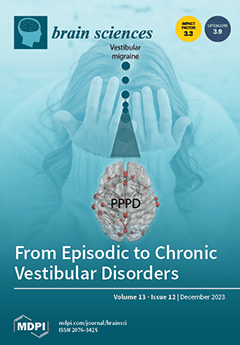Flumazenil is an allosteric modulator of the γ-aminobutyric acid-A receptor (GABA
AR) benzodiazepine binding site that could normalize neuronal signaling and improve motor impairments in Parkinson’s disease (PD). Little is known about how regional GABA
AR availability affects motor symptoms. We
[...] Read more.
Flumazenil is an allosteric modulator of the γ-aminobutyric acid-A receptor (GABA
AR) benzodiazepine binding site that could normalize neuronal signaling and improve motor impairments in Parkinson’s disease (PD). Little is known about how regional GABA
AR availability affects motor symptoms. We investigated the relationship between regional availability of GABA
AR benzodiazepine binding sites and motor impairments in PD. Methods: A total of 11 Patients with PD (males; mean age 69.0 ± 4.6 years; Hoehn and Yahr stages 2–3) underwent [
11C]flumazenil GABA
AR benzodiazepine binding site and [
11C]dihydrotetrabenazine vesicular monoamine transporter type-2 (VMAT2) PET imaging and clinical assessment. Stepwise regression analysis was used to predict regional cerebral correlates of the four cardinal UPDRS motor scores using cortical, striatal, thalamic, and cerebellar flumazenil binding estimates. Thalamic GABA
AR availability was selectively associated with axial motor scores (R
2 = 0.55, F = 11.0, β = −6.4,
p = 0.0009). Multi-ligand analysis demonstrated significant axial motor predictor effects by both thalamic GABA
AR availability (R
2 = 0.47, β = −5.2, F = 7.2,
p = 0.028) and striatal VMAT2 binding (R
2 = 0.30, β = −3.9, F = 9.1,
p = 0.019; total model: R
2 = 0.77, F = 11.9,
p = 0.0056). Post hoc analysis demonstrated that thalamic [
11C]methyl-4-piperidinyl propionate cholinesterase PET and
K1 flow delivery findings were not significant confounders. Findings suggest that reduced thalamic GABA
AR availability correlates with worsened axial motor impairments in PD, independent of nigrostriatal degeneration. These findings may augur novel non-dopaminergic approaches to treating axial motor impairments in PD.
Full article






